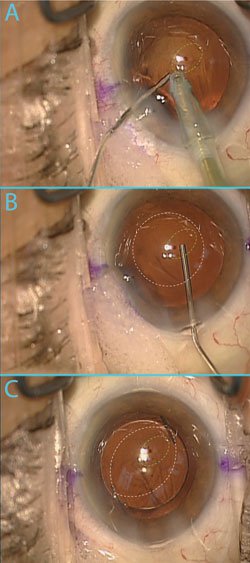Despite an open posterior capsule, vitreous prolapse can be prevented
Maintaining pressure in the anterior segment and creating a blockade with a dispersive viscoelastic are good preventive measures.
 Uday Devgan |
An open posterior capsule is most commonly seen after we perform Nd:YAG laser capsulotomies to treat posterior capsule opacification. As long as the posterior capsule opening is smaller than the lens optic, there is no risk of vitreous prolapse into the anterior segment of the eye. But sometimes the posterior capsule can inadvertently be opened during cataract surgery, and other times surgeons may intentionally create a posterior capsulotomy as part of the surgery. It is during these situations that we need to prevent vitreous prolapse and securely place the IOL.
Creating a posterior capsulotomy
In pediatric cataract surgery, the risk of severe posterior capsule opacification is so high that a posterior capsulotomy as well as an anterior vitrectomy is commonly performed at the time of the initial procedure. Other cataract types such as posterior polar, posterior lenticonus and posterior plaque can be treated with a primary posterior capsulorrhexis at the time of cataract surgery. The technique for creating a posterior capsulorrhexis is similar to that for an anterior capsulorrhexis with one important difference: The anterior segment pressure must be kept higher than the vitreous cavity pressure in order to prevent vitreous prolapse.
More commonly, the posterior capsule opening is inadvertently created during routine cataract surgery by a surgical instrument or perhaps a pre-existing weakness in the capsule. Centrally, the posterior capsule is just 4 µm to 8 µm thin, and it can be ruptured suddenly.
Keep the anterior segment pressurized
The first step is to recognize the posterior capsule break and then to maintain the fluid infusion via the irrigation and aspiration probe. It is critical that the surgeon does not pull the infusion instrument out of the eye yet. Premature withdrawal of the infusion will allow the anterior segment pressure to drop, and then a pressure gradient will be created. With higher pressure in the vitreous cavity than in the anterior segment, vitreous will then prolapse through the posterior capsule opening. By maintaining the infusion, the inflow pressure is sustained and vitreous will not prolapse forward.
A dispersive viscoelastic can now be injected through the posterior capsular opening to create a barrier to keep the vitreous back and prevent prolapse. It is important to use a dispersive viscoelastic, which is more liquid like honey, instead of a cohesive viscoelastic, which is more solid like gelatin. The dispersive nature allows the viscoelastic to remain in place, tamponading the vitreous, without being displaced during further manipulation such as lens insertion. The anterior chamber should also be filled with viscoelastic in order to pressurize it and maintain a gradient that will further help prevent vitreous prolapse.
Optic capture of the IOL
In this situation, with an open posterior capsule and an intact 5-mm anterior capsulorrhexis, the ideal IOL is a three-piece design with a 6-mm optic. While this IOL can be placed entirely in the ciliary sulcus, a better option is to capture the optic through the anterior capsulorrhexis. This is done by first placing the entire IOL into the sulcus and then using a second instrument to push the optic through the capsulorrhexis. This is not easily accomplished with single-piece acrylic IOL designs, which are contraindicated for sulcus placement due to their design.
 (A) Once a posterior capsule break (outlined in green) is detected, a dispersive viscoelastic is injected through the defect to prevent vitreous prolapse while the infusion via the irrigation and aspiration probe is maintained. (B) More viscoelastic is injected via the main incision to keep the anterior segment pressurized and to tamponade the vitreous. (C) The three-piece IOL is placed with the haptics in the sulcus and the optic captured through the anterior capsulorrhexis (outlined in white), which becomes ovoid in shape. Image: Devgan U |
The optic has a diameter of 6 mm so it can be securely held by the 5-mm wide capsulorrhexis, similar to a button through a buttonhole. The round capsulorrhexis then becomes ovoid in shape, and it provides excellent long-term stability and centration of the optic. Importantly, this allows the IOL optic to act as a strong barrier between the anterior and posterior segments of the eye and prevents any vitreous prolapse.
If the IOL is placed entirely in the sulcus, the IOL power needs to be decreased by about 0.5 D to 1 D because the effective lens position is more anterior than is the case with in-the-bag placement. For an IOL with optic capture, the optic is anatomically in the capsular bag, so there is essentially no change in the IOL power from the original calculations.
Summary
With an open posterior capsule, maintaining pressure in the anterior segment and creating a blockade with a dispersive viscoelastic helps to prevent vitreous prolapse. A three-piece IOL can then be placed with the optic capture technique to ensure long-term stability and create a barrier so that the case can be completed. These patients tend to have a routine postoperative course with no further complications and excellent visual results.

- Uday Devgan, MD, FACS, FRCS, is in private practice at Devgan Eye Surgery in Los Angeles and Beverly Hills. He can be reached at 11600 Wilshire Blvd., Suite 200, Los Angeles, CA 90025; 800-337-1969; fax: 310-388-3028; email: devgan@gmail.com; website: www.DevganEye.com.
- Disclosure: No products or companies are mentioned that would require financial disclosure.
